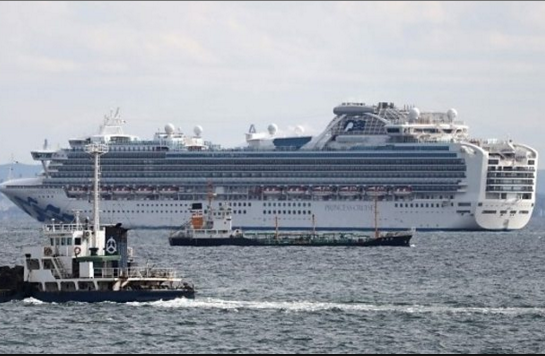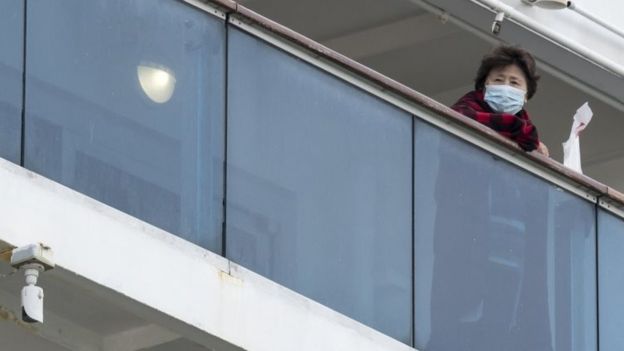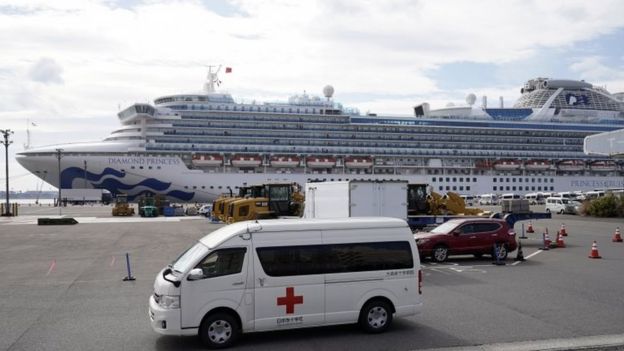Coronavirus: Are cruise ships really ‘floating Petri dishes’?
By Yvette Tan From BBC

The largest coronavirus outbreak outside mainland in China is not in a country, but on a cruise ship.
It’s been more than a week since the Diamond Princess went into lockdown, after a previous passenger tested positive for the virus after disembarking.
With almost 500 out of 3,700 people on board tested, 174 people have now tested positive for coronavirus. Those still on board are in quarantine for another week.
But it’s not just the Diamond Princess.
On another cruise ship in Hong Kong, 3,600 passengers people were quarantined because of fears that people on board might have the virus.
They were only allowed to disembark after tests came back negative.
And a cruise ship carrying more than 1,450 passengers, which left Hong Kong on 1 February, was turned away from ports in Japan, Taiwan, Guam and the Philippines, despite having no infections on board. It has now been told it can dock in Cambodia.
Cruise ships have for years been referred to as “floating Petri dishes” – places ripe for the exchange of germs, and the spreading of illness.
But is the accusation true?


Do viruses spread more easily on cruise ships?
There is an increased risk of respiratory and gastrointestinal diseases on ships, says Prof Sanjaya Senanayake, an infectious diseases specialist at the Australian National University.
“In general, you’ve got passengers and crew members from different parts of the world mixing intimately and intensely for a short period of time,” Dr Senanayake says.
“They’ve all got varying levels of immunity and so that does set things up for an infection outbreak.”
With coronavirus, which is believed to spread through droplets – such as from mucus or saliva – people could be infected without direct contact with a carrier.
“Say if someone sneezed on to a table, and then someone else immediately touches that table, that could lead to infection,” Dr Senanayake says.
“People might not all be talking to each other – but they are in shared spaces like swimming pools, spas, dining rooms and auditoriums.”
However, Stewart Chiron, a cruise expert, says “the reality onboard a cruise is very different to the perception of it”.
“So for example, people think that when you’re queuing up at buffet lines that there’s a lot of interaction and contact between passengers,” says Mr Chiron, who has been on board more than 250 cruise ships.
“For the major cruise lines, that’s not true. There are stations – if you want eggs you go to the egg station, a gloved crew member will do that for you.
“The point is that you’re rarely waiting in a line, and not everyone passes by every piece of food – what that does is minimise the interaction between people.”


But what about crew members?
If passenger interaction is minimised, crew interaction is another story.
On the Diamond Princess, at least 10 crew members are among the infected. According to the New York Times, more than 1,000 crew members “live and work elbow-to-elbow”.
“It’s likely crew members will be in very close contact with each other, perhaps even sharing facilities,” says Dr Senanayake.
“People will disembark the ship but the crew members often may not change. So if there is ongoing transmission from the crew, when the next set of passengers come on that may continue.”
How are the risks mitigated?
According to Mr Chiron, cruises have extremely stringent cleaning and screening processes.
“Cruises are always taking thorough readings of passengers. If you look ill then you are subject to a secondary medical screening.”
Probably the disease most associated with cruise ships is norovirus, a vomiting illness caught via contaminated food or water, or by touching contaminated surfaces.
“Cruises have various protocols that are enabled when a norovirus case is reported,” says Mr Chiron.
“There’s extensive scrubbing that goes on, all the surfaces are continuously cleaned. During the buffets there will be no food like bread baskets. The crew are specially trained for this.”


He adds that things have become more stringent since the outbreak of the coronavirus.
“You can tell now they’re much more observant of passengers’ appearances. If you look at how well ships are cleaned and maintained – they are extremely thorough.”
According to Dr Senanayake, there is an official Vessel Sanitation Program at the US Centre for Disease Control and Prevention (CDC) that advises ships on how to prevent and control the spread of illnesses.
“I believe cruise ships now have got a lot of disinfection stations, and are also advising patients or crew members who are sick not to come on board,” he says.
“There is that risk of going on a cruise ship but everything in life comes with risks. [People just have to] practice simple [precautionary] measures.”
For the Diamond Princess, Dr Senanayake says the ship is employing “good isolation measures” by keeping people in their rooms (passengers are allowed onto the outdoor decks at certain times).
However, he adds: “[The ship] needs to make sure people understand why this is happening and understand their concerns.
“You’ve gone from having the time of your life to being isolated in your room feeling very scared. The quarantine should always be done in a very humane and compassionate way.”
Is the industry suffering?
The cruise industry will definitely take a “financial hit” – but these cases aren’t going to stop people from taking cruises, says Mr Chiron.
“The damage they’re going to take specifically is from the cruises around China and South East Asia. The lines themselves are cancelling routes.
“Cruise Norwegian, for example, are cancelling all their Asia sailings. They are going to have to issue refunds, credits – we’re talking hundreds of millions of dollars.
“But when you look at the rest of the world, Europe, Alaska, the US – people are still travelling. Royal Caribbean revealed that just 1.5% of enquiries they received were about people asking the virus.
“People are concerned, yes, but they are still travelling. Elsewhere in the world the ships are full and they are going to continue to be full.”
For more on this story and video go to: https://www.bbc.com/news/world-asia-51470603





